Many of the adjustments covered here involve the Custom Functions menu. You can access this menu only when the camera's Mode dial is set to P, Tv, Av, or M.
Change the function of the Canon EOS Rebel T7 Set button
Normally, the main role of the Set button during shooting is to select items from the camera menus and Quick Settings screens. In the P, Tv, Av, or M exposure modes, though, you can set the button to perform a different function during shooting. (The button still performs its regular operations when a menu or Quick Settings screen is displayed.) To modify the Set button assignment, select Custom Functions from Setup Menu 3 and then press the left/right cross keys until you see Custom Function 9, shown in the following figure.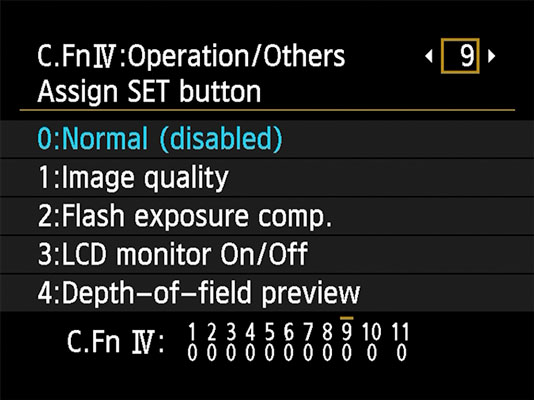 You can configure the Set button to perform an extra function.
You can configure the Set button to perform an extra function.Choose from these alternative Set button functions:
- Image Quality: Displays the screen where you can change the Image Quality setting.
- Flash Exposure Compensation: Displays the setting that enables you to adjust flash power.
- LCD Monitor On/Off: Toggles the Shooting Settings screen on and off. (This function doesn't work in Live View mode.)
- Depth-of-Field Preview: If you press and hold the Set button down, the lens aperture stops down to the chosen f-stop, giving you a preview of how the aperture setting affects depth of field. You can see the change happen in the viewfinder or, when Live View is engaged, on the camera monitor. Both displays may become pretty dark at high f-stop settings, which limits the amount of light entering through the lens.
Customize the Canon EOS Rebel T7's AE Lock and Shutter buttons
By default, you initiate autofocusing by pressing the shutter button halfway and lock autoexposure by pressing the AE (autoexposure) Lock button. I recommend that you stick with this setup while learning about your camera; otherwise, my instructions won’t work, and neither will the ones in the camera manual. But after you feel more comfortable, you may want to customize the locking behaviors of the two buttons.
To configure the buttons, set the Mode dial to P, Tv, Av, or M. Then head for Custom Function 8. As shown in the following figure, you can choose from the following configuration options. The part of the option name before the slash indicates the result of pressing the shutter button halfway; the name after the slash indicates the result of pressing the AE Lock button.
- AF/AE Lock: This is the default setting. Pressing the shutter button halfway initiates autofocus; pressing the AE Lock button locks autoexposure.
- AE Lock/AF: With this option, pressing the shutter button halfway locks autoexposure. To initiate autofocusing, press the AE Lock button. In other words, this mode is the exact opposite of the default setup.
- AF/AF Lock, No AE Lock: Pressing the shutter button halfway initiates autofocusing and exposure metering, and pressing the AE Lock button locks focus. Autoexposure lock isn’t possible.
This option is designed to prevent focusing mishaps when you use AI Servo autofocusing, a viewfinder-shooting option. In AI Servo mode, the autofocus motor continually adjusts focus from the time you press the shutter button halfway until the time you take the image. This feature helps keep moving objects focused. But if something moves in front of your subject, the camera may mistakenly focus on that object instead. To cope with that possibility, this locking option enables you to initiate autofocusing as usual, by pressing the shutter button halfway. But at any time before you take the picture, you can hold down the AE Lock button to stop the autofocusing motor from adjusting focus. Releasing the button restarts autofocusing. Exposure is set at the time you take the picture.
- AE/AF, No AE Lock: In this mode, press the shutter button halfway to initiate autoexposure and press the AE Lock button to autofocus. In AI Servo mode, continuous autofocusing occurs only while you hold down the AE Lock button, which is helpful if your subject repeatedly moves and then stops. Exposure is set at the moment you take the picture.
 Adjust autoexposure and autofocus lock behavior via Custom Function 8.
Adjust autoexposure and autofocus lock behavior via Custom Function 8.Disable the AF-assist beam on the Canon EOS Rebel T7
In dim lighting, your camera may emit an AF (autofocus)-assist beam from the built-in flash when you press the shutter button halfway — assuming that the flash unit is open, of course. This pulse of light helps the camera “see” its target better, improving the performance of the autofocusing system. In situations where the AF-assist beam may be distracting, you can disable it in the P, Tv, Av, or M exposure modes. Make the change via Custom Function 7, which offers these choices:- Enable: This setting is the default and turns the AF-Assist Beam function on.
- Disable: You can figure this one out.
- Enable External Flash Only: Choose this setting to permit an external flash unit to emit the beam but prevent the built-in flash from doing so. (The idea is to save you the time and hassle of revisiting the Custom Functions setting to enable or disable the beam every time you switch from the built-in flash to an external flash — two settings in one, if you will.) The external flash must be a compatible EX-series Speedlite unit, such as the Speedlite 430EX II.
- IR AF Assist Beam Only: This setting allows an external Canon EOS Speedlite with infrared (IR) AF-assist to use only the IR beam to aid in focusing instead of pulsing a series of small flashes like the built-in flash does when it tries to play autofocus guide dog. This setting gives you the best of both worlds: an AF assist beam that is invisible to the naked eye.
An external Canon Speedlite has its own provision to disable the AF-assist beam. If you turn off the beam on the flash unit, it won’t light no matter which Custom Functions setting you choose.
Silence the Canon EOS Rebel T7 camera
By default, your camera beeps after certain operations, such as after it sets focus when you use autofocusing and during the timer-countdown when you use the Self-Timer Drive mode. If you need the camera to hush up, set the Beep option on Shooting Menu 1 to Disable. This option is available in all shooting modes.Prevent shutter release on the Canon EOS Rebel T7 without a memory card
By default, you can take a picture without any memory card in the camera. But the image you shoot is only temporary, appearing for just a few seconds on the monitor and then dissolving into digital nothingness. During the instant image-review period, your camera warns you that there's no card in the camera. You also see a warning message on the monitor if no card is installed when you turn on the camera.
If you’re wondering about the point of this option, it’s designed for use in camera stores, enabling salespeople to demonstrate cameras without having to keep a memory card in every model. Unless that describes the way you're using the camera, turn this feature off by opening Shooting Menu 1 and changing the Release Shutter without Card option to disable. The camera then prevents the shutter button from releasing and tricking you into thinking you just took a picture.Reduce the number of exposure stops on the Canon EOS Rebel T7
In photography, the term stop refers to an increment of exposure. To increase exposure by one stop means to adjust the aperture or shutter speed to allow twice as much light into the camera as the current settings permit. To reduce exposure a stop, you use settings that allow half as much light. Doubling or halving the ISO value also adjusts exposure by one stop.
By default, major exposure-related settings on your camera are based on one-third stop adjustments. If you prefer, you can tell the camera to present exposure adjustments in half-stop increments so that you don't have to cycle through as many settings each time you want to make a change. Make your preferences known via Custom Function 1.Note that when you use the 1/2-stop setting, the exposure meter appears slightly different in the Shooting Settings display and Live View display than you see it in this book: Only one intermediate notch appears between each number on the meter instead of the usual two. The viewfinder meter doesn't change, but the exposure indicator bar appears as a double line if you set the Exposure Compensation value to a half-step value (+0.5, +1.5, and so on).
Create your own Canon EOS Rebel T7 camera menu
Through the My Menu feature, you can create a custom menu containing up to six items from the camera’s other menus. Grouping menu items this way makes it easier to access the options you use most frequently because they're all on one menu. Take these steps to create a custom menu:1. Set the camera Mode dial to P, Tv, Av, or M.
You can create and order from the custom menu only in these exposure modes.
2. Press Menu and rotate the Main dial to bring up the My Menu screen.The menu is represented by a green star and initially shows only a single item: My Menu Settings, as shown on the left here.
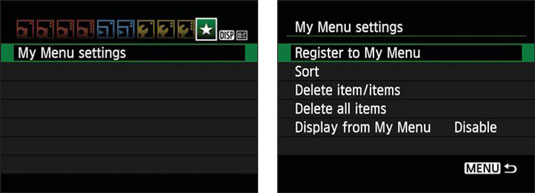 The My Menu feature lets you put six favorite menu options on a single menu.
The My Menu feature lets you put six favorite menu options on a single menu.3. Choose My Menu Settings.
The screen shown on the right in the figure appears.
4. Choose Register to My Menu.You see a scrolling list that contains every item found on the camera’s menus, as shown on the left in the following figure. Scroll the menu screen by using the up/down cross keys.
5. Highlight the first item to include on your custom menu.To add a specific Custom Function to your menu, scroll past the item named Custom Functions to find and highlight the individual function. (The item named Custom Functions simply puts the Custom Functions menu item on your menu, and you still have to wade through multiple levels of steps to reach the function you want to change.)
6. Press Set to display the confirmation screen shown on the right in the following figure.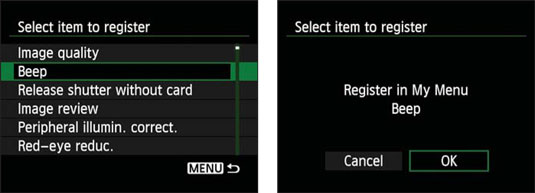 Highlight an option you want to put on your menu (left) and press Set to display a confirmation screen (right).
Highlight an option you want to put on your menu (left) and press Set to display a confirmation screen (right).7. Highlight OK and press Set.
The list of menu items reappears, with the option you just added to your menu dimmed in the list.
8. Repeat Steps 5 through 7 to add up to five additional items to your menu.9. Press the Menu button to return to the My Menu Settings screen.
10. Press the Menu button again to return to the My Menu screen.
The items you added appear on the menu. You now can access those menu options either through your custom menu or their regular menu.
After creating your menu, you can manage it as follows:- Give your menu priority. You can tell the camera that you want it to automatically display your custom menu anytime you press the Menu button. To do so, choose My Menu Settings on the main My Menu screen to display the screen shown on the right side of the preceding image. Then set the Display from My Menu option to Enable.
- Change the order of the list of menu items. Once again, navigate to the right screen. This time, choose the Sort option. Highlight a menu item, press Set, and then press the up/down cross keys to move the menu item up or down in the list. Press Set again to glue the menu item in its new position.
- Delete menu items. Display your menu, choose My Menu Settings, and then choose Delete Item/Items (refer to the right screen). Highlight the menu item that you want to delete and press Set. On the resulting confirmation screen, choose OK and then press the Set button.
To remove all items from your custom menu, choose Delete All Items (again, refer to the right side of the figure) and press Set. On the confirmation screen, highlight OK and press Set.
Create custom folders on your Canon EOS Rebel T7/2000D
Normally, your camera automatically creates folders to store your images. The first folder has the name 100Canon; the second, 101Canon; the third, 102Canon; and so on. Each folder can hold 9,999 photos. If you want to create a new folder before the existing one is full, choose Select Folder from Setup Menu 1 and then choose Create Folder, as illustrated here. You might take this organizational step so that you can separate work photos from personal photos, for example.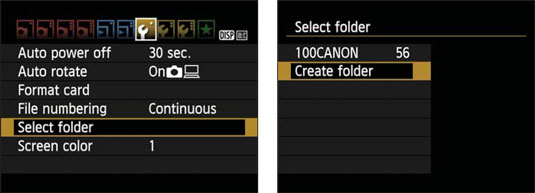 You can create a new image-storage folder at any time.
You can create a new image-storage folder at any time.The camera asks for permission to create the folder; choose OK and press Set. The folder is automatically assigned the next available folder number and is selected as the active folder — the one that will hold any new photos you shoot. Press the Set button to return to Setup Menu 1.
To make a different folder the active folder, choose Select Folder again, choose the folder you want to use, and press Set.
If you select a folder that contains images, two thumbnails appear to the right of the folder name. The top thumbnail shows the first image in the folder, along with the last four numbers of its filename. The bottom thumbnail shows the last image in the folder.
Turn off the Canon EOS Rebel T7/2000D Shooting Settings screen
When you turn on your camera, the monitor automatically displays the Shooting Settings screen. At least, it does if you stick with the default setting selected for Custom Function 11, which bears the lengthy name LCD Display When Power On and appears here.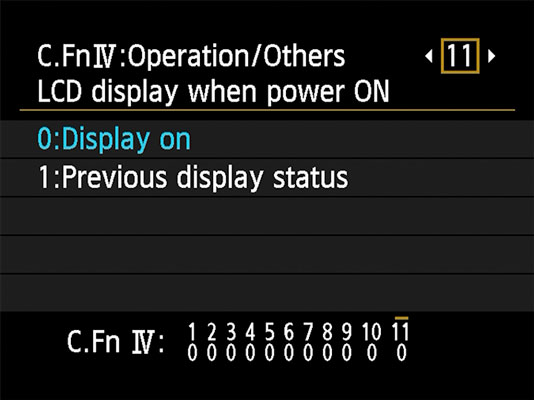 This option affects whether the Shooting Settings screen appears when you turn on the camera.
This option affects whether the Shooting Settings screen appears when you turn on the camera.You can prevent the monitor from displaying the screen every time you power up the camera by changing this setting from Display On to Previous Display Status. The monitor is one of the biggest drains on the camera battery, so limiting it to displaying information only when you need it can extend the time between battery charges.
Note the setting name, though: Previous Display Status. At this setting, the camera operates just as the name implies. The camera preserves the monitor status when you turn the camera off and then back on again. If the Shooting Settings screen was displayed when you turned off the camera, it will appear the next time you power up. If the screen was off when you turned off the camera, it remains dark when you turn the camera back on. You then have to press the DISP button to view the screen.
I find all this way too much to remember, so I leave this option at the default and just use the DISP button to turn off the monitor when needed.If you do want to take advantage of this feature, note that as with other Custom Functions, it works only when the camera is set to P, Tv, Av, or M exposure mode. In other modes, the screen still appears automatically.
Change the color space from sRGB to Adobe RGB
By default, your camera captures photographs and movies using the sRGB color mode, which simply refers to an industry-standard spectrum of colors. (The s is for standard, and the RGB is for red, green, blue, which are the primary colors in the digital color world.) The sRGB color mode was created to help ensure color consistency as an image moves from camera (or scanner) to monitor and printer; the idea was to create a spectrum of colors that all these devices can reproduce.However, the sRGB color spectrum leaves out some colors that can be reproduced in print and onscreen, at least by some devices. So, as an alternative, your camera also offers the Adobe RGB color mode — which includes a larger spectrum of colors. It's important to know that some colors in the Adobe RGB spectrum can’t be reproduced in print; the printer just substitutes the closest printable color, if necessary.
So which option is right for you? Well, the point is moot for movie recording; you can’t record a movie in the Adobe RGB color space. For photographs, most people are better off sticking with sRGB because most printers and web browsers are designed around that color space. Second, to retain all your original Adobe RGB colors when you work with your photos, your editing software must support that color space, and not all programs do. You also must be willing to study the whole topic of digital color a little bit because you need to use some specific settings to avoid really mucking up the color works.
To use Adobe RGB, you must shoot in the advanced exposure modes: P, Tv, Av, and M. After setting the Mode dial to one of those settings, make your decision known via the Color Space option on Shooting Menu 2, shown here. In other modes, the camera automatically selects sRGB. Additionally, your color space selection is applied to only your JPEG images; with Raw captures, you select the color space as you process the Raw image and convert it to a JPEG or TIFF, not when you capture it.
 Choose sRGB unless you’re savvy about image color management.
Choose sRGB unless you’re savvy about image color management.After you transfer pictures to your computer, you can tell whether you captured an image in the Adobe RGB color space by looking at its filename: Adobe RGB images start with an underscore, as in _MG_0627.jpg. Pictures captured in the sRGB color space start with the letter I, as in IMG_0627.jpg.






